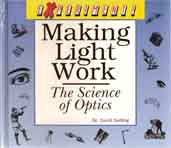MAKING LIGHT WORK: The Science of Optics - Glossary
aperture
The opening in a camera or eye through which light can enter. Changing the size of the aperture controls the amount of light that can pass through.
compact disk (CD)
A form of storage for music and other kinds of information. It consists of a plastic disk with a mirrorlike coating onto which a pattern of tiny pits and blanks is put. This pattern is scanned by a laser inside a CD player.
concave
A concave mirror or lens is one that dips inward from the edge to the center.
convex
A convex mirror or lens is one that bulges outward from the edge to the center.
density
A measure of how concentrated a piece of matter is. It is equal to the amount of matter, or mass, inside a given volume.
eclipse
The blocking of light from a bright object by something that passes in front of it. Eclipses of the sun are caused by the moon moving between the sun and the Earth.
electromagnetic wave
A type of wave that can travel across empty space. Light, radio waves, and X-rays are various types of electromagnetic waves, differing only in their wavelength.
energy
A measure of the ability to do work or cause movement.
filter
A material that only allows light within a certain range of wavelengths to pass through.
focal length
The distance from the center of a mirror or lens to the point at which light rays are brought together (the focus).
image
The appearance of an object formed by a mirror or lens.
iris
The colored part of the eye which contains muscles for opening and closing the pupil.
laser
A device for producing a very pure, narrow beam of light. Laser light consists of waves of a single wavelength that move exactly in step.
lens
A round, curved piece of transparent material that can be used to focus light or form an image at a particular point.
magnify
To increase the apparent size of an object by using one or more curved lenses or mirrors.
matter
The stuff of which a thing is made. It may be a solid, liquid, or gas.
opaque
An opaque substance is one that completely stops light from passing through.
optical fiber
A specially made strand of glass that allows light to travel through it over long distances.
primary color
A color that cannot be made by mixing together other colors of light. These are three primary colors – red, green, and blue.
prism
A solid block of glass, with triangular ends, that can split white light into all the colors of the rainbow.
pupil
The tiny opening in the middle of the iris through which light enters the eyeball.
reflection
The bouncing back of light from a surface.
refraction
The change of direction that a light ray undergoes when it passes from one transparent substance into another.
retina
The thin layer at the back of the eye that is sensitive to light.
secondary color
A color that can be made by mixing together two of the primary colors of light. These are three secondary colors – yellow, cyan, and magenta.
spectrum
The complete spread of wavelengths of light. It includes all the colors of the rainbow from red to violet.
translucent
A translucent substance is one through which light can pass but which prevents things from being seen clearly.
transparent
A transparent substance lets light pass through and objects be seen clearly on the other side.
wavelength
The distance from one peak in a series of waves to the next.

